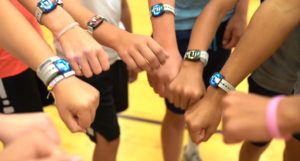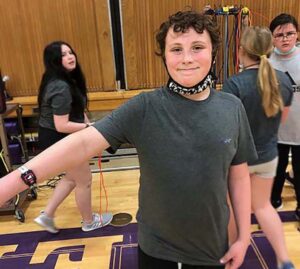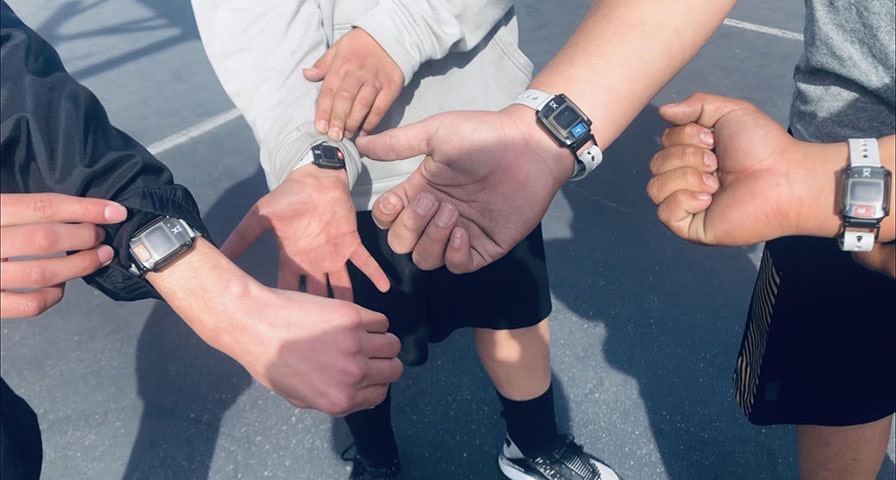Students wearing IHT ZONE wrist heart rate monitors during their physical education classes often discover new reasons to participate and enjoy classes.
“The out-of-shape student who maybe hated PE, they are wearing the monitor and all of a sudden they are yelling out, ‘Hey, Mr. Smith, I’m in yellow’ or ‘I’m in red,’’ San Bernardino City USD PE Specialist Scott Smith said.
Reinventing a Program with Heart Rate Technology
Smith added the heart rate monitors in 2019 as the final step in a multi-year effort to reinvent a program that struggled to meet student needs. Transitioning toward a fitness-based program and away from games that didn’t motivate students to move put Smith’s program on the right track, but the heart rate monitors took it to another level, he said.
“The heart rate monitors were a game-changer,” Smith said. “The kids felt like they had something to come to class for. IT gave them the power they never thought they had and it allowed us as teachers to push the students, the good and the bad.”
The IHT ZONE heart rate monitors provide students with key real-time and post-session feedback, including:
- Displaying their actual heart rate reading by beats per minute
- Displaying the heart rate zone by color: blue for low activity, yellow for moderate activity, red for vigorous activity
- Providing a summary report via email detailing the students heart rate throughout class, including how many minutes they spent in each heart rate zone and if they met the daily goal for minutes of MVPA
The heart rate monitor measured each student’s performance against their own abilities, not against other students.
“They finally felt that we were thinking about them as indivduals,” Smith said. “We were not grading them against somebody else. What we were finding is that they were completely taking control of the situation.”
A New Way to Assess Students
So much of PE assessment focused on either a teacher’s observations based on what he saw from students or standardized assessment results such as the tests that comprise common fitness assessments, notably the PACER or 20-meter shuttle, where students must run from line to line in a certain interval.
The students who do well in these tests are students who are already fit. Students who struggle with fitness don’t typically score very well on the tests. That, in turn, often has a negative impact on their overall feelings.
“Fitness testing and in particular the PACER is a test of maximum cardiovascular effort,” award-winning New York PE teacher Doug Hallberg said. “The reality is, until devices like this, the (out-of-shape) kid always felt singled out. That’s horrifying to me.”
 Hallberg continues to use the assessment tests, but he balances that with what he – and the student – sees on the heart rate monitor.
Hallberg continues to use the assessment tests, but he balances that with what he – and the student – sees on the heart rate monitor.
“I tell my students I want you to do the absolute best that you can as evidenced by you getting into the red zone,” he said. “If you get to the red zone, you are giving me everything you have at that moment, and that’s all I can ask for.”
If the results show that the student needs to work on their fitness, he has that conversation, but he can come at it with the perspective of helping a student improve what their best effort can be.
“Now that kid can raise his hand when he’s in the red and feel like he did what he needed to do,” Hallberg said. “And then the next time, if they go (one lap farther), I know they’re still not fit but at least they’re making progress, and they can be proud of that. And if they’re proud, and making progress, then they are much more likely to want to continue.”
Changing Student Attitudes Toward PE
 In his San Bernardino program, Smith surveys his students regularly to make sure the program continues to connect with students. His most recent survey showed that 71% of his students felt the heart rate monitors pushed students to set goals, 83% said heart rate monitors made PE relevant, and 94% gave the program a rating of four or five on a scale of one to five with five being a great experience.
In his San Bernardino program, Smith surveys his students regularly to make sure the program continues to connect with students. His most recent survey showed that 71% of his students felt the heart rate monitors pushed students to set goals, 83% said heart rate monitors made PE relevant, and 94% gave the program a rating of four or five on a scale of one to five with five being a great experience.
Those results emphasize what Smith learned from talking with students. Most importantly, he said, students are active and self-esteem is high. And those students who didn’t like PE before? Almost all of them have changed their view.
“We had a lot of students who would say these words in general: ‘I hated PE,’ ‘PE is not fun,’ or ‘PE is not for me,’” Smith said. “I would say at this point that 90% of those students, if not more, have changed their opinion of PE.”
What sparked the change?
“They can look at the data from their monitor and see that they have the power to make a difference in themselves,” Smith said. “They are no longer being graded against somebody else, and that allows them to push themselves and set their own goals. They are open to conversations about their health and fitness because they feel better about themselves.”


